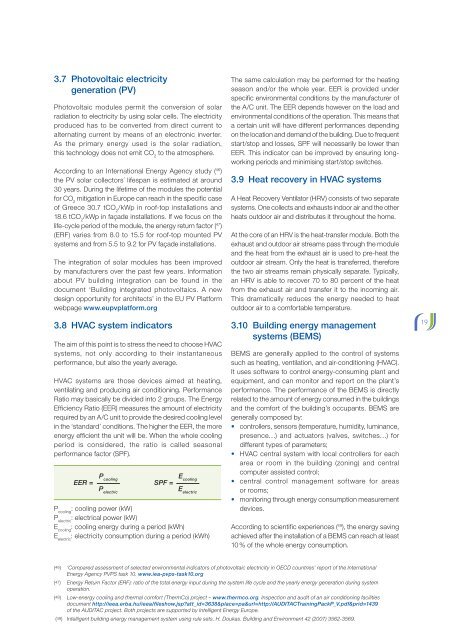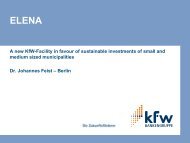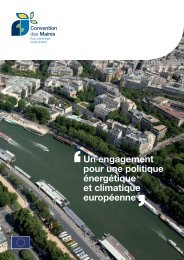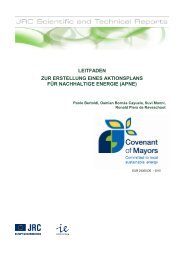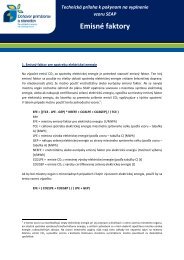English - Covenant of Mayors
English - Covenant of Mayors
English - Covenant of Mayors
Create successful ePaper yourself
Turn your PDF publications into a flip-book with our unique Google optimized e-Paper software.
3.7 Photovoltaic electricitygeneration (PV)Photovoltaic modules permit the conversion <strong>of</strong> solarradiation to electricity by using solar cells. The electricityproduced has to be converted from direct current toalternating current by means <strong>of</strong> an electronic inverter.As the primary energy used is the solar radiation,this technology does not emit CO 2to the atmosphere.According to an International Energy Agency study ( 46 )the PV solar collectors´ lifespan is estimated at around30 years. During the lifetime <strong>of</strong> the modules the potentialfor CO 2mitigation in Europe can reach in the specific case<strong>of</strong> Greece 30.7 tCO 2/kWp in ro<strong>of</strong>-top installations and18.6 tCO 2/kWp in façade installations. If we focus on thelife-cycle period <strong>of</strong> the module, the energy return factor ( 47 )(ERF) varies from 8.0 to 15.5 for ro<strong>of</strong>-top mounted PVsystems and from 5.5 to 9.2 for PV façade installations.The integration <strong>of</strong> solar modules has been improvedby manufacturers over the past few years. Informationabout PV building integration can be found in thedocument ‘Building integrated photovoltaics. A newdesign opportunity for architects’ in the EU PV Platformwebpage www.eupvplatform.org3.8 HVAC system indicatorsThe aim <strong>of</strong> this point is to stress the need to choose HVACsystems, not only according to their instantaneousperformance, but also the yearly average.HVAC systems are those devices aimed at heating,ventilating and producing air conditioning. PerformanceRatio may basically be divided into 2 groups. The EnergyEfficiency Ratio (EER) measures the amount <strong>of</strong> electricityrequired by an A/C unit to provide the desired cooling levelin the ‘standard’ conditions. The higher the EER, the moreenergy efficient the unit will be. When the whole coolingperiod is considered, the ratio is called seasonalperformance factor (SPF).P coolingEER = SPF =P electricE coolingE electricP cooling: cooling power (kW)P electric: electrical power (kW)E cooling: cooling energy during a period (kWh)E electric: electricity consumption during a period (kWh)The same calculation may be performed for the heatingseason and/or the whole year. EER is provided underspecific environmental conditions by the manufacturer <strong>of</strong>the A/C unit. The EER depends however on the load andenvironmental conditions <strong>of</strong> the operation. This means thata certain unit will have different performances dependingon the location and demand <strong>of</strong> the building. Due to frequentstart/stop and losses, SPF will necessarily be lower thanEER. This indicator can be improved by ensuring longworkingperiods and minimising start/stop switches.3.9 Heat recovery in HVAC systemsA Heat Recovery Ventilator (HRV) consists <strong>of</strong> two separatesystems. One collects and exhausts indoor air and the otherheats outdoor air and distributes it throughout the home.At the core <strong>of</strong> an HRV is the heat-transfer module. Both theexhaust and outdoor air streams pass through the moduleand the heat from the exhaust air is used to pre-heat theoutdoor air stream. Only the heat is transferred, thereforethe two air streams remain physically separate. Typically,an HRV is able to recover 70 to 80 percent <strong>of</strong> the heatfrom the exhaust air and transfer it to the incoming air.This dramatically reduces the energy needed to heatoutdoor air to a comfortable temperature.3.10 Building energy managementsystems (BEMS)BEMS are generally applied to the control <strong>of</strong> systemssuch as heating, ventilation, and air-conditioning (HVAC).It uses s<strong>of</strong>tware to control energy-consuming plant andequipment, and can monitor and report on the plant’sperformance. The performance <strong>of</strong> the BEMS is directlyrelated to the amount <strong>of</strong> energy consumed in the buildingsand the comfort <strong>of</strong> the building’s occupants. BEMS aregenerally composed by:• controllers, sensors (temperature, humidity, luminance,presence…) and actuators (valves, switches…) fordifferent types <strong>of</strong> parameters;• HVAC central system with local controllers for eacharea or room in the building (zoning) and centralcomputer assisted control;• central control management s<strong>of</strong>tware for areasor rooms;• monitoring through energy consumption measurementdevices.According to scientific experiences ( 49 ), the energy savingachieved after the installation <strong>of</strong> a BEMS can reach at least10 % <strong>of</strong> the whole energy consumption.19(46) ‘Compared assessment <strong>of</strong> selected environmental indicators <strong>of</strong> photovoltaic electricity in OECD countries’ report <strong>of</strong> the InternationalEnergy Agency PVPS task 10. www.iea-pvps-task10.org(47) Energy Return Factor (ERF): ratio <strong>of</strong> the total energy input during the system life cycle and the yearly energy generation during systemoperation.(48) Low-energy cooling and thermal comfort (ThermCo) project – www.thermco.org. Inspection and audit <strong>of</strong> an air conditioning facilitiesdocument http://ieea.erba.hu/ieea/fileshow.jsp?att_id=3638&place=pa&url=http://AUDITACTrainingPackP_V.pdf&prid=1439<strong>of</strong> the AUDITAC project. Both projects are supported by Intelligent Energy Europe.(49) Intelligent building energy management system using rule sets. H. Doukas. Building and Environment 42 (2007) 3562-3569.


